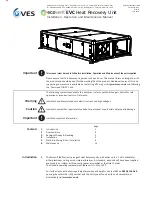
23
Per far scendere le pedane, alzare con la pompa a mano il
sollevatore un paio di cm. per dare la possibilità alle sicu-
rezze meccaniche di disinserirsi, alzare gli arpioni della sicu-
rezza meccanica con una tavoletta di legno spessa ca. 3 cm.
e posizionarla per tutta la lunghezza della cremagliera (vedi
fig. 20)., con una chiave esagonale da “5” svitare lentamen-
te la valvola di discesa manuale (operatore manuale rif. fig.
21) prestando attenzione alla discesa del sollevatore, quan-
do il sollevatore sarà arrivato a terra riavvitare la valvola.
Riparato il guasto, alzare il sollevatore e togliere lo spessore
in legno dalla sicurezza meccanica.
DIAGNOSTICA
SINTOMO 1
1)
Pulsante di salita premuto ed il ponte rimane fermo (il
motore non gira)
PROBABILE CAUSA 1:
1A)
Mancanza di alimentazione elettrica su scheda e su tra-
sformatore (pos. 34, 14 fig. 26)
RIMEDIO -
Controllare l’efficienza dei relativi fusibili.
Qualora fossero saltati verificare la causa del cortocir-
cuito e sostituire i fusibili (pos. 41, 36 fig. 26)
1B)
Mal funzionamento del TUCH PAD.
RIMEDIO -
Controllare tramite tester, sui puntalini, la
funzionalità del TUCH PAD sostituendolo se guasto.
1C)
Scheda guasta.
RIMEDIO -
Controllare se premendo i pulsanti del
La ricerca dei guasti e gli eventuali interventi di ripa-
razione richiedono il rispetto di tutte le precauzioni di sicu-
rezza indicate al cap. “3” ed al cap.”6”.
DISCESA MANUALE
CAP. 7
- INCONVENIENTI E RIMEDI
CHAPTER 7
- TROUBLESHOOTING
MANUAL PUMP / POMPA MANUALE
LOWERING E.V.
ELETT. VALVOLA DISCESA
MANUAL OPERATOR
OPERATORE MANUALE
MAX PRESSURE
VALVE
VALVOLA DI
MASSIMA
LEVELLING E.V.
ELETT. VALVOLA
LIVELLO
To lower the platforms, raise the lift with the hand pump
about 2cm. in order to disengage the mechanical safety devi-
ces. Lift the mechanical safety pawls using a wooden shim of
about 3cm and place it along the rack (picture 20).With a
“5” hexagonal key, unscrew very slowly the hand lowering
valve (manual operator, picture 21), carefully following the
lift lowering. When the lift is fully lowered, screw the hand
lowering valve. Once the trouble has been repaired, rais
ethe lift and remove the wooden shims.
TROUBLESHOOTING
SYMPTOM 1
1)
The lifting button is pushed but the lift does not move (the
motor does not run)
POSSIBLE CAUSE 1:
1A)
Lack of electric feed on the electric card and on the tran-
sformer. (pos. 34, 14 picture 26)
REMEDY -
Check the relative fuse. In case of blown
fuse, replace them (pos. 41, 36 picture. 26)
1B)
Malfunctioning touchpad.
REMEDY -
Check the touchpad with a tester and repla-
ce it if faulty.
1C)
Difective electric card.
REMEDY -
Check whether the relays and leds are acti-
vated by pushing the buttons on the touchpad. (pos. DL
picture14).
1D)
Uncertain connections between the electric card and the
Troubleshooting and possible repairs requireabsolute
compliance with all safety precautions indicated in chapters
3 and 6.
MANUAL LOWERING
fig. 20
pict. - fig. 21
















































